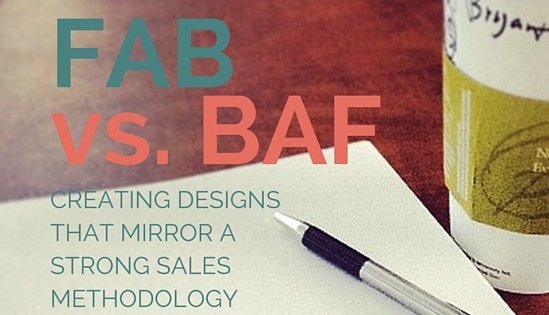FAB vs. BAF: Merging Sales Methodologies with Strong Design Practices
What's The Logical Approach to a Pitch?
The logical order of an everyday (consultative) pitch can be used to better organize your website's important information and CTAs (calls to action). Consider a 60-second elevator pitch: the consultant must give you one or two key (and relevant) talking points and hopefully leave you with enough insight to either make a decision or ask for more information (both being positive outcomes). The trick with the pitch is to keep it as concise and engaging as possible.
What happens when the consultant doesn't get to pitch the client directly?
We rely on our company webpages so much that we depend on them to be the 24-7-365 employee. The employee that never sleeps or takes a sick day. For this reason, we have bombarded our databases with every talking point, every graphic, every product to the extent that the user/client/customer doesn't really need the salesman/pitchman/consultant to make a pitch or tailor information to their specific needs. Many companies rely on their website to be the single-most important point of contact and therefore, attempt to cram as much information into their website as possible.
Over time, businesses tend pack an enormous amount of information into their websites to the point where it becomes an inverted-pyramid of data (more thoughts in an upcoming post); the need and focus of the website's key information becomes clouded with other non-pertinent information. The vast modi operandi is shifting, significantly.
"The customer doesn't care about features — they care about solving their problems."
— Trish Bertuzzi
In this case, get to the point. Try not navigate your users and potential customers through an analysis-paralysis-experience by creating a complex web layout and information structure. As an age-old sales methodology goes, positioning and presenting a product can be done in one of two ways. The first, is to lead with the feature (F) of a product, then transition into the advantage (A) of the product's feature, and finally, with fervor, close with the benefit (B) (of a product's advantage and feature).
This is the FAB method.
Conversely, it is arguably a more qualitative approach to flip that same process and lead with the product or service's benefit (BAF) while educating a client or customer on a given product. Leading with the benefit is also a more consultative and personal approach, while leading with a feature just exudes sales pitch.
Organizing a pitch into these three steps, it is said, helps to keep the presentation concise and on point with the client's needs. Otherwise, the presentation can delve into topics unnecessary to closing a deal and also just a waste of everyone's time by clouding the conversation, likely leading to indecision.
Applying This to Your Website
With this, albeit simplistic, pitch-methodology and reasoning in mind, think of your company's website. Is it a cluttered, inverted-pyramid of information and data?
Remember, if you will, the purpose of your website? This approach doesn't apply to all sites of course, and certainly is not limited only to Ecommerce sites.
Assuming your website exists beyond the sole purpose of having a domain, your website will have CTAs and a reason for users to interact. I have been in meetings with business leaders who struggle to explain the purpose of their business' website with precision; the company may have a strong vision, purpose with growth opportunities on the doorstep, however the strategic-groundwork hasn't been done for digital.
At TAVO Interactive, we focus on Digital Transformations for companies, an effort that has a rather wide blast radius, targeting offline-and-online business ecosystem-unity. A large part of this effort is targeting the purpose for a company's communication with its end-user, its customer. This strategic approach allows us to dig deep, sifting through a mass of content and data to come up with the most important talking points, and in many cases: the Features, Advantages and Benefits.
From there, seasoned user-experience designers align these key elements into an engaging user-flow, distilling key points, from the important aspects of your business goals, necessary for a user to spend just a few fleeting seconds to get informed and take action. After all, your business methodologies and messaging shouldn't differ whether online or off.
In the offline world, a pitch should be conversational, yet to the point.
Remember, your website should reflect that same simplicity at its core: Get to the point.


